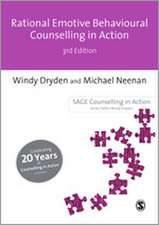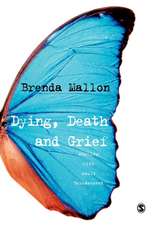Leadership for Resilient Schools and Communities
Autor Mike M. Milstein, Doris Annie Henryen Limba Engleză Paperback – 11 feb 2008
Preț: 300.88 lei
Nou
Puncte Express: 451
Preț estimativ în valută:
57.58€ • 59.49$ • 47.90£
57.58€ • 59.49$ • 47.90£
Carte tipărită la comandă
Livrare economică 19 martie-02 aprilie
Preluare comenzi: 021 569.72.76
Specificații
ISBN-13: 9781412955942
ISBN-10: 1412955947
Pagini: 200
Dimensiuni: 216 x 279 x 12 mm
Greutate: 0.56 kg
Ediția:Second Edition
Editura: SAGE Publications
Colecția Corwin
Locul publicării:Thousand Oaks, United States
ISBN-10: 1412955947
Pagini: 200
Dimensiuni: 216 x 279 x 12 mm
Greutate: 0.56 kg
Ediția:Second Edition
Editura: SAGE Publications
Colecția Corwin
Locul publicării:Thousand Oaks, United States
Recenzii
"Building a foundation of resiliency will help schools and communities strengthen their futures. Milstein and Henry establish an excellent set of guiding principles. Every educational administrator needs to read and reflect upon this important work."
"The book provides a wide selection of practical and user-friendly tools and strategies for understanding the meaning and importance of resiliency. A must for teachers, school leaders, boards of trustees, and parents concerned about the well-being of their schools and communities."
"Contains an excellent combination of theory and practice concerning resiliency. The conversational style and practical ideas are very useful in helping me as a leader get my head around making the transition from textbook to school and community reality."
"In a world that continues to offer new challenges to students' and adults' sense of personal and professional well-being and commitment to community, this highly practical yet deeply thoughtful book is a must-read, must-use for leaders in schools, communities, and businesses. No other book in the field of resiliency manages to combine the deep thought and practical wisdom of its authors in such a powerful way."
"The resiliency work within our school allowed staff to identify their individual strengths, which then contributed to the collective power of the team by building avenues for quality communication within our professional community."
"Milstein and Henry have done policy makers and education practitioners an enormous service by developing the concept of resiliency—the capacity to adapt in the face of adversity—as a practical way of engaging communities in school improvement."
"The authors provide strategies that educators, leaders, and students need to cope with life's challenges and make the most of life's possibilities."
"Milstein and Henry have given us a blueprint to create schools and communities that will spread resiliency in young people. The book is a guide for making schools and communities healthier places, and it shows how to create an environment that will produce healthier adults and children. It is not merely a call to action, but a primer for making it happen."
"With this achievement of a book, Milstein and Henry offer both a clear rationale for advocating resiliency as a goal and a practical guide for progressing on the path toward resiliency."
“A practical, powerful guide to creating healthier school environments, offering an interactive workbook format packed with successful strategies.”
"The book provides a wide selection of practical and user-friendly tools and strategies for understanding the meaning and importance of resiliency. A must for teachers, school leaders, boards of trustees, and parents concerned about the well-being of their schools and communities."
"Contains an excellent combination of theory and practice concerning resiliency. The conversational style and practical ideas are very useful in helping me as a leader get my head around making the transition from textbook to school and community reality."
"In a world that continues to offer new challenges to students' and adults' sense of personal and professional well-being and commitment to community, this highly practical yet deeply thoughtful book is a must-read, must-use for leaders in schools, communities, and businesses. No other book in the field of resiliency manages to combine the deep thought and practical wisdom of its authors in such a powerful way."
"The resiliency work within our school allowed staff to identify their individual strengths, which then contributed to the collective power of the team by building avenues for quality communication within our professional community."
"Milstein and Henry have done policy makers and education practitioners an enormous service by developing the concept of resiliency—the capacity to adapt in the face of adversity—as a practical way of engaging communities in school improvement."
"The authors provide strategies that educators, leaders, and students need to cope with life's challenges and make the most of life's possibilities."
"Milstein and Henry have given us a blueprint to create schools and communities that will spread resiliency in young people. The book is a guide for making schools and communities healthier places, and it shows how to create an environment that will produce healthier adults and children. It is not merely a call to action, but a primer for making it happen."
"With this achievement of a book, Milstein and Henry offer both a clear rationale for advocating resiliency as a goal and a practical guide for progressing on the path toward resiliency."
“A practical, powerful guide to creating healthier school environments, offering an interactive workbook format packed with successful strategies.”
Cuprins
Dedication
List of Tables and Figures
List of Handouts
Foreword by Richard A. Schmuck
Foreword to the First Edition by Paul D. Houston
Preface
Organization of the Book
About the Authors
Part I. Basic Concepts
1. Resiliency: Promoting Everyone’s Potential to Succeed
Why the Urgency?
An Introduction to Resiliency
The Problem With Problem Solvers
2. Building Resilient Communities
Why Community Development and Resiliency
Traditional Ways of Thinking About Community
Three Realities of Community: Rural, Urban, and Suburban
Visualizing the Resilient Community
Leadership Activities for Building a Resilient Community: Where Do We Start?
Part II. Resiliency for Everyone
3. Student Resiliency: Building a Base for Positive Living
What Are the Problems That Youth Face?
Changing Our Mind Maps: From Deficits to Potentials
Student Resiliency: The Community and School’s Responsibilities
Leadership Strategies That Promote Student Resiliency
Bringing It All Together as an Overall Resiliency-Building Approach
4. Educator Resiliency: Nurturing the Nurturers
Resiliency Pathways and Educators’ Performance Over Their Career Span
The Ability of Educators to Perform Well Over Time: Coping With Plateauing
The Impact of the School Environment on Educator Resiliency
Strategies to Overcome School-Based Barriers to Educator Resiliency
5. School Resiliency: Creating Supportive Environments for Students, Educators, and Communities
Does Your School Support Resiliency?
Improving School Resiliency Means Changing Schools
Backwards Planning
School Resiliency-Building Strategies
6. Community Resiliency: Developing Partnerships
Building Relationships Between Schools and Their Communities
Communities With Characteristics of Resiliency
Community Support Is Needed for School Resiliency
School Support Is Needed for Community Resiliency
From Reactive to Proactive Community Relationships
Strategies for Improving Community Resiliency
Part III. Making It Happen for Schools & Communities
7. Leading Resiliency Development Initiatives: Strategies for Managing and Assessing Change
Bringing It All Together and Leading Resiliency Development Initiatives
The Four Stages of Change
Group Development
Leadership Needs
Facilitation Skills
Assessment, Monitoring, and Evaluation
8. School and Community Resiliency Initiatives
A Reality Perspective
Communities on the Forefront of Improvement
In Closing
Resource A: Handouts
References
Index
List of Tables and Figures
List of Handouts
Foreword by Richard A. Schmuck
Foreword to the First Edition by Paul D. Houston
Preface
Organization of the Book
About the Authors
Part I. Basic Concepts
1. Resiliency: Promoting Everyone’s Potential to Succeed
Why the Urgency?
An Introduction to Resiliency
The Problem With Problem Solvers
2. Building Resilient Communities
Why Community Development and Resiliency
Traditional Ways of Thinking About Community
Three Realities of Community: Rural, Urban, and Suburban
Visualizing the Resilient Community
Leadership Activities for Building a Resilient Community: Where Do We Start?
Part II. Resiliency for Everyone
3. Student Resiliency: Building a Base for Positive Living
What Are the Problems That Youth Face?
Changing Our Mind Maps: From Deficits to Potentials
Student Resiliency: The Community and School’s Responsibilities
Leadership Strategies That Promote Student Resiliency
Bringing It All Together as an Overall Resiliency-Building Approach
4. Educator Resiliency: Nurturing the Nurturers
Resiliency Pathways and Educators’ Performance Over Their Career Span
The Ability of Educators to Perform Well Over Time: Coping With Plateauing
The Impact of the School Environment on Educator Resiliency
Strategies to Overcome School-Based Barriers to Educator Resiliency
5. School Resiliency: Creating Supportive Environments for Students, Educators, and Communities
Does Your School Support Resiliency?
Improving School Resiliency Means Changing Schools
Backwards Planning
School Resiliency-Building Strategies
6. Community Resiliency: Developing Partnerships
Building Relationships Between Schools and Their Communities
Communities With Characteristics of Resiliency
Community Support Is Needed for School Resiliency
School Support Is Needed for Community Resiliency
From Reactive to Proactive Community Relationships
Strategies for Improving Community Resiliency
Part III. Making It Happen for Schools & Communities
7. Leading Resiliency Development Initiatives: Strategies for Managing and Assessing Change
Bringing It All Together and Leading Resiliency Development Initiatives
The Four Stages of Change
Group Development
Leadership Needs
Facilitation Skills
Assessment, Monitoring, and Evaluation
8. School and Community Resiliency Initiatives
A Reality Perspective
Communities on the Forefront of Improvement
In Closing
Resource A: Handouts
References
Index
Notă biografică
Mike M. Milstein is a partner in The Resiliency Group, Ltd., and Professor Emeritus of Educational Leadership at the University of New Mexico. His professional career also includes being Professor of Educational Leadership at the University of Buffalo and a classroom teacher. His teaching, research, and writing interests are in the areas of resiliency and organizational change and development. He has been actively engaged in school and community resiliency development efforts in such places as Nelson, New Zealand, Ashland, Oregon; Battle Creek, Michigan; and Shelby County, Tennessee. The resiliency initiatives he has facilitated include classroom instruction and curriculum improvement efforts, school wide activities that enhance the resiliency of educators, and school-community partnerships that support resiliency development for both children and adults. He has written 11 books, including coauthoring Resiliency in Schools (2002; 1996).
Descriere
Combining proven strategies with new information for developing resiliency in schools, this edition emphasizes the critical role of school leaders and features updated exercises for implementing change.











